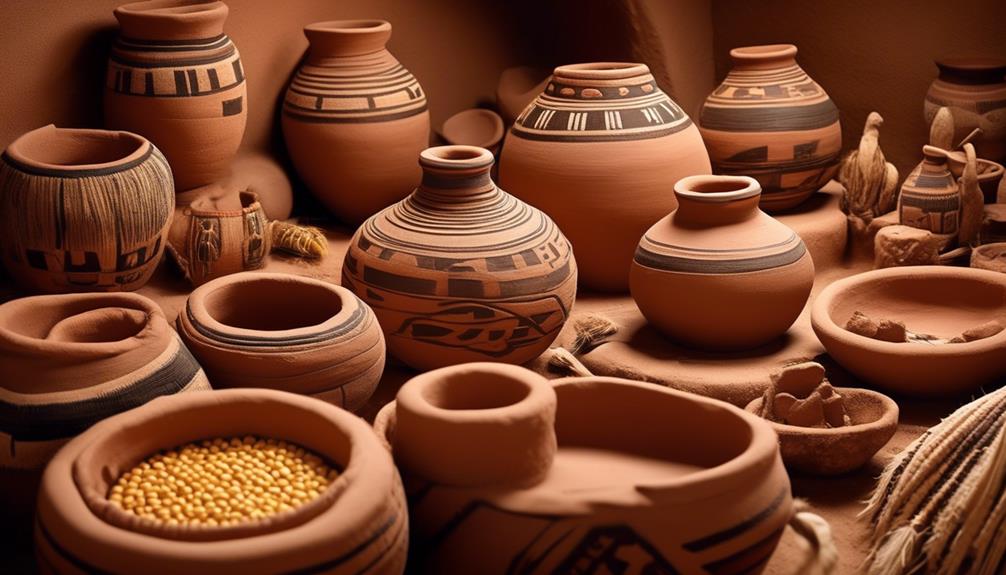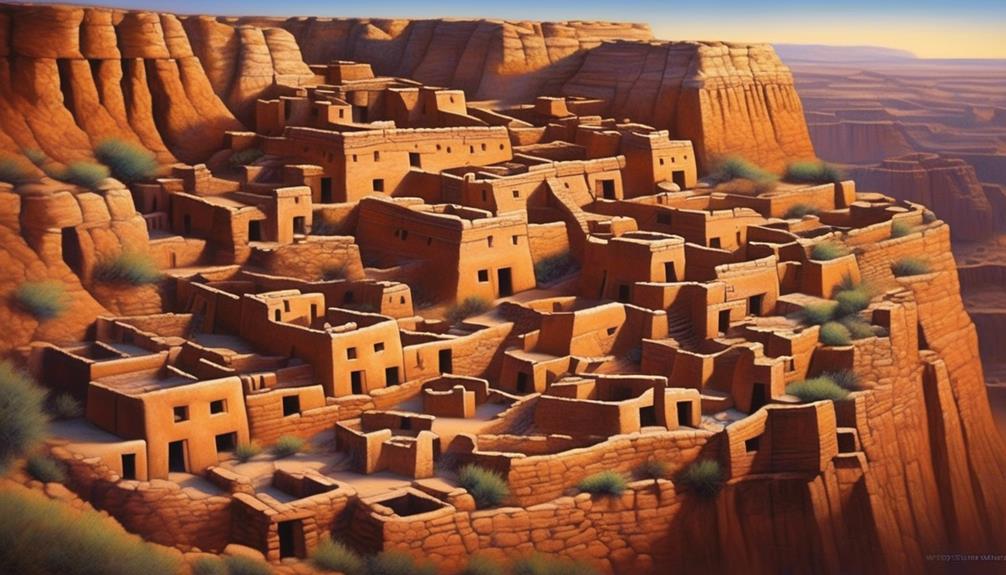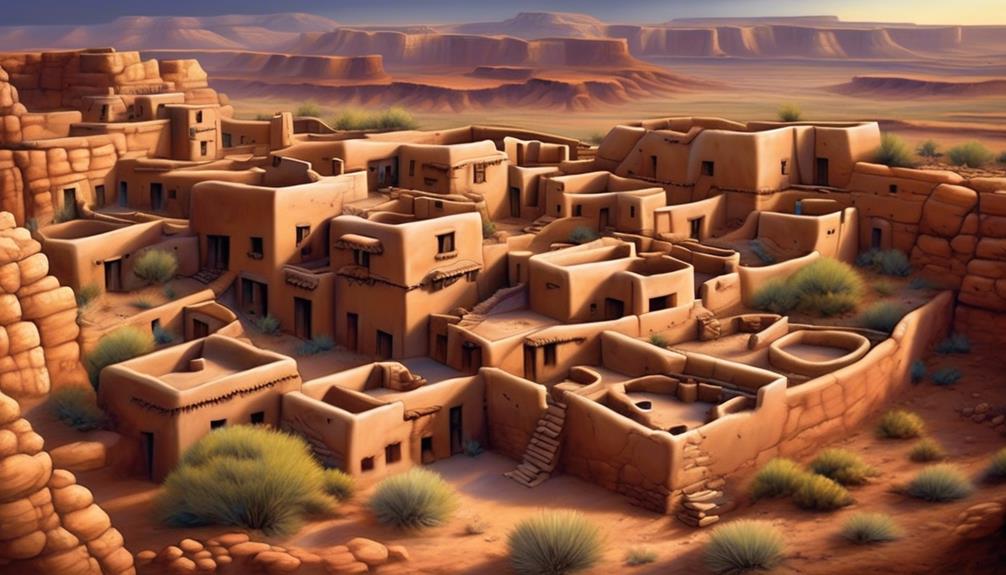The Hopi people, recognized for their vibrant culture and strong tie to the earth, relied on a diverse range of resources to maintain their traditional lifestyle.
It's fascinating to note that despite residing in a desert region with limited natural resources, the Hopi managed to thrive for centuries. Their resourcefulness and ingenuity in utilizing the environment around them is truly remarkable.
From crafting intricate pottery using clay to implementing sustainable water management techniques, the Hopi tribe's utilization of resources offers valuable insights into their ancient practices.
As we explore the various resources they used, we'll uncover the ingenious methods they employed to not only survive but to prosper in their environment.
Key Takeaways
- Hopi pottery showcases their deep connection to the earth and cultural traditions
- Stone tools were used for dwelling construction, crafting essential implements, hunting, and food preparation
- Natural dyes extracted from plants were used for textiles, symbolizing connection to the land and artistic ingenuity
- Intricate water management techniques were used to sustain the community and enrich cultural practices, including irrigation, terraced fields, and a network of canals and ditches.
Clay and Pottery
The art of pottery making among the Hopi people showcases their deep connection to the earth and their rich cultural traditions. Hopi pottery techniques have been passed down through generations, reflecting the tribe's reverence for the natural world.
The process begins with clay sourcing and preparation, a vital aspect of their pottery tradition. The Hopi people carefully select clay from specific locations, each with unique qualities that contribute to the final product. Once gathered, the clay undergoes a meticulous preparation process, where it's cleaned, mixed with temper, and kneaded to achieve the desired consistency. This attention to detail ensures that the pottery will be durable and of the highest quality.
Comparatively, the Hopi pottery techniques differ from those of other indigenous tribes, as each tribe's methods are influenced by their environment and cultural practices. The Hopi's clay-sourcing rituals and techniques are integral to the pottery-making process, embodying the tribe's respect for nature and their ancestors. This holistic approach to pottery making not only produces exquisite art but also serves as a means of preserving the tribe's heritage and honoring their connection to the earth.
Stone Tools and Construction
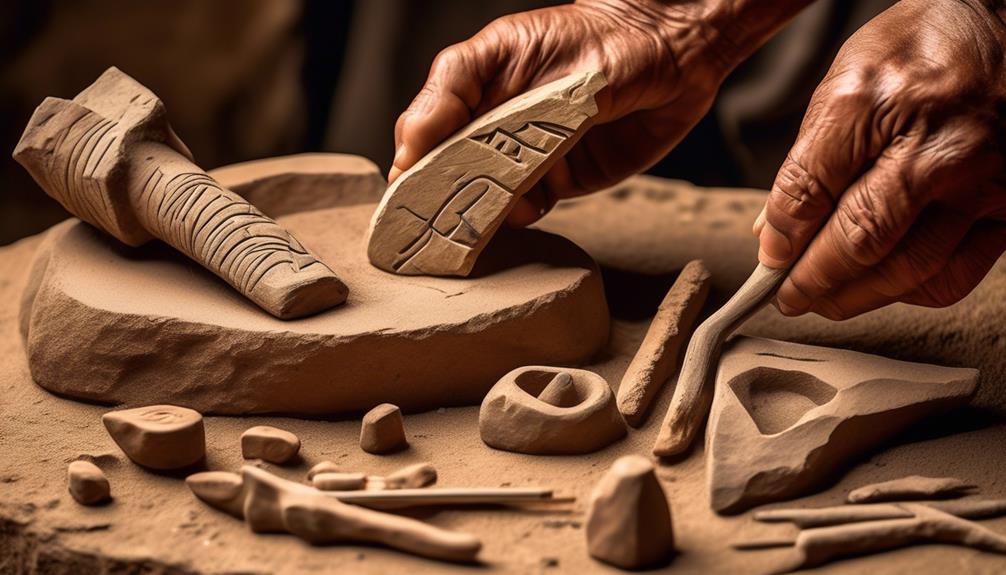
Utilizing stone tools, we construct our dwellings and craft essential implements, embodying our tribe's resourceful and enduring spirit. Our stone tool technology has been finely honed over generations, allowing us to fashion sturdy tools and construct enduring structures. The art of stonework is deeply ingrained in our cultural heritage, and it forms the cornerstone of our architectural techniques.
Our use of stone tools extends beyond mere construction; it permeates every aspect of our daily lives. From shaping arrowheads and knives for hunting and crafting, to fashioning grinding stones for food preparation, our reliance on stone tools is comprehensive. The resilience and versatility of these tools have allowed us to thrive in our challenging desert environment.
In our architectural techniques, we employ the strength and durability of stone to build our homes, called pueblos, which are emblematic of our enduring connection to the land. These multi-story structures are carefully constructed using locally sourced stones, reflecting our harmonious relationship with the natural world.
Plant-based Resources
Embodying our tribe's resourceful and enduring spirit, our reliance on stone tools seamlessly extends to a rich utilization of plant-based resources, shaping the very fabric of our daily lives and cultural practices.
Natural dyes extracted from plants like rabbitbrush, sage, and prickly pear have been instrumental in our textile traditions, producing a vibrant spectrum of colors and patterns that adorn our clothing and ceremonial regalia. These dyes not only symbolize our connection to the land but also serve as a testament to our artistic ingenuity and resourcefulness.
Furthermore, our profound understanding of medicinal plants has been passed down through generations, forming the basis of our healing traditions. Plants such as yarrow, juniper, and bee plant have been crucial in treating various ailments and injuries, reflecting the deep knowledge of our healers and the interconnectedness of our physical and spiritual well-being.
Through the harmonious integration of these plant-based resources into our daily lives, we've cultivated a sustainable and holistic relationship with the natural world, fostering a profound respect for its abundance and wisdom.
Water Management and Utilization
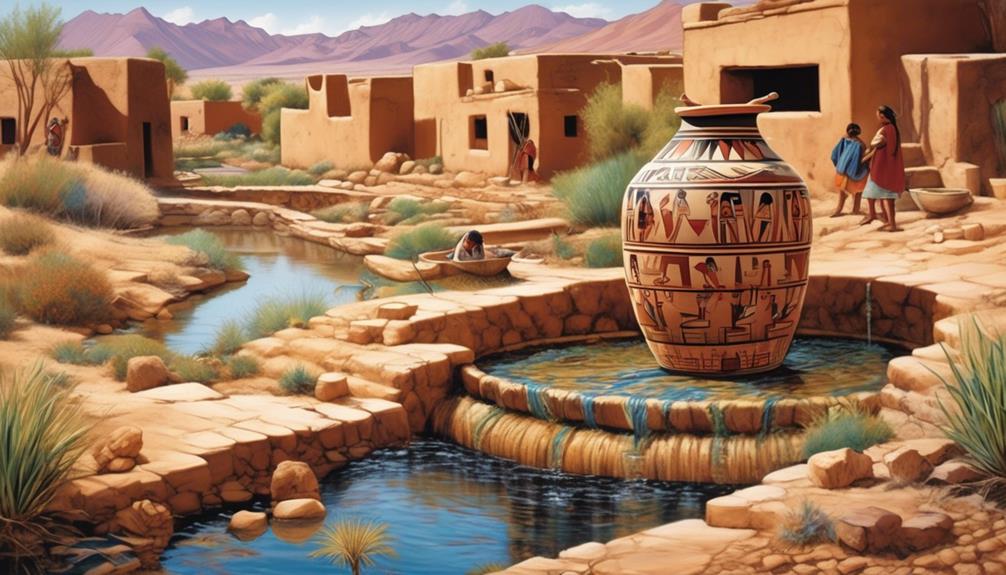
Drawing upon our ancestral wisdom and harmonious relationship with the natural world, we've developed intricate water management techniques that sustain our community and enrich our cultural practices.
Our irrigation techniques are deeply rooted in sustainable practices, allowing us to efficiently utilize water for our agricultural practices. We employ a system of terraced fields that capture and retain water, maximizing its distribution to crops.
By carefully observing the land's natural contours, we've designed a network of canals and ditches to divert water from streams and rivers, ensuring that every plant receives the nourishment it needs. Our agricultural practices benefit from this thoughtful approach, as we cultivate a diverse array of crops that thrive in the arid desert climate.
Through our water management and utilization, we not only ensure the prosperity of our crops but also maintain a delicate balance with nature. This ancient knowledge continues to guide us, demonstrating the importance of sustainable water management in preserving our cultural heritage and sustaining our community for generations to come.
Sustainable Resource Practices
In our commitment to preserving our cultural heritage and sustaining our community for future generations, we prioritize sustainable resource practices that honor our ancestral wisdom and harmonious relationship with the natural world.
The Hopi Tribe has long practiced sustainable hunting and gathering methods, deeply rooted in our traditions and respect for the land. Our hunting practices are guided by a profound understanding of animal populations and their ecological roles, ensuring that we harvest in harmony with nature's rhythms to maintain balance. Similarly, our gathering techniques are imbued with reverence for the Earth, as we carefully select plants and herbs, mindful of their regenerative capacity.
Furthermore, land stewardship lies at the heart of our sustainable resource practices. Through our traditional agricultural methods, we nurture the soil and safeguard biodiversity, upholding the principle of giving back to the land that sustains us. By rotating crops and practicing water conservation, we honor the interconnectedness of all living things and strive to leave the land even more fruitful for future generations.
Our sustainable resource practices serve as a testament to the enduring wisdom of our ancestors and our commitment to safeguarding the natural world.
Frequently Asked Questions
What Were the Spiritual or Cultural Significance of the Resources Used by the Hopi Tribe?
Spiritual practices and cultural traditions were integral to the Hopi tribe's use of resources. These resources held deep significance, connecting the tribe to their beliefs, values, and heritage.
The tribe's spiritual practices were intertwined with the natural world, and the resources they used played a vital role in ceremonies, rituals, and daily life.
The cultural significance of these resources enriched the tribe's identity, fostering a deep connection to their traditions and ancestral wisdom.
How Did the Hopi Tribe Trade or Exchange Their Resources With Neighboring Tribes or Communities?
Trading was vital for the Hopi tribe. We exchanged surplus crops, pottery, and crafts with neighboring tribes. Bartering was a common practice, and goods like turquoise, shells, and cotton were traded for.
The Hopi's strategic location facilitated trade, allowing for the exchange of resources and ideas. This interaction nurtured a rich cultural tapestry, enhancing our way of life.
Did the Hopi Tribe Have Any Specific Rituals or Ceremonies Related to the Gathering or Use of Resources?
In our culture, ritual ceremonies and resource gathering traditions hold deep significance.
Our tribe has specific rituals and ceremonies dedicated to the gathering and use of resources. These traditions are integral to our way of life, honoring the earth and ensuring proper stewardship of the resources we rely on.
We celebrate these practices with reverence, passing down the wisdom and customs to future generations.
How Did the Hopi Tribe Pass Down Knowledge of Resource Utilization From Generation to Generation?
Passing down knowledge of resource utilization from generation to generation is a crucial part of our culture. We've preserved traditional practices like resource rituals and ceremonial practices, emphasizing their cultural and spiritual significance.
Our tribe has also adapted to modern challenges while preserving our traditions. We've engaged in resource trading with neighboring tribes, enriching our understanding of generational resource utilization.
It's remarkable how our heritage continues to shape our approach to resources.
What Challenges Did the Hopi Tribe Face in Maintaining and Preserving Their Traditional Resource Practices in the Modern World?
Challenges faced by the Hopi tribe in preserving traditional resource practices in the modern world are numerous. From environmental changes to encroaching development, these pose significant obstacles. The tribe's efforts to maintain and pass down resource practices are impacted by these modern challenges.
Striking a balance between tradition and adaptation to the modern world is essential for preserving their heritage. It's a delicate dance, but one that the Hopi tribe is determined to continue.
Conclusion
In conclusion, the Hopi tribe used a wide range of resources to sustain their community. They utilized clay and stone for various purposes, such as constructing homes and creating pottery. Additionally, they relied on plants for food and medicine, and they understood the importance of water for their survival. The Hopi were the original experts in sustainable living, implementing practices that were environmentally friendly and efficient. They were pioneers in utilizing resources in a way that ensured their long-term availability. So next time you're sipping on your artisanal, eco-friendly latte, just remember the Hopi were doing it way before it was trendy. They were the OGs of sustainable resource practices.
